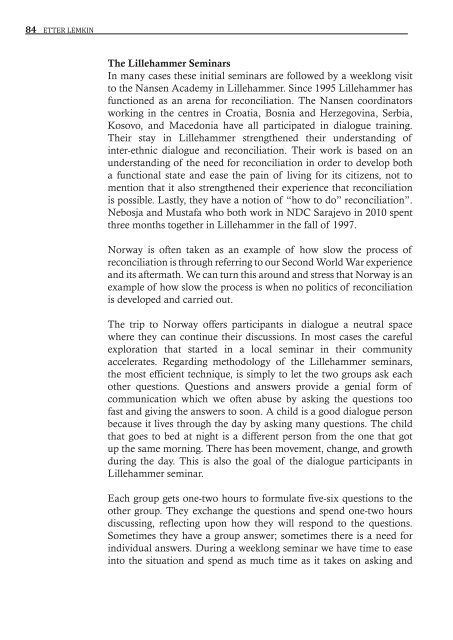Utgave - Etter Lemkin
Utgave - Etter Lemkin
Utgave - Etter Lemkin
Create successful ePaper yourself
Turn your PDF publications into a flip-book with our unique Google optimized e-Paper software.
84 ETTER LEMKIN<br />
The Lillehammer Seminars<br />
In many cases these initial seminars are followed by a weeklong visit<br />
to the Nansen Academy in Lillehammer. Since 1995 Lillehammer has<br />
functioned as an arena for reconciliation. The Nansen coordinators<br />
working in the centres in Croatia, Bosnia and Herzegovina, Serbia,<br />
Kosovo, and Macedonia have all participated in dialogue training.<br />
Their stay in Lillehammer strengthened their understanding of<br />
inter-ethnic dialogue and reconciliation. Their work is based on an<br />
understanding of the need for reconciliation in order to develop both<br />
a functional state and ease the pain of living for its citizens, not to<br />
mention that it also strengthened their experience that reconciliation<br />
is possible. Lastly, they have a notion of “how to do” reconciliation”.<br />
Nebosja and Mustafa who both work in NDC Sarajevo in 2010 spent<br />
three months together in Lillehammer in the fall of 1997.<br />
Norway is often taken as an example of how slow the process of<br />
reconciliation is through referring to our Second World War experience<br />
and its aftermath. We can turn this around and stress that Norway is an<br />
example of how slow the process is when no politics of reconciliation<br />
is developed and carried out.<br />
The trip to Norway offers participants in dialogue a neutral space<br />
where they can continue their discussions. In most cases the careful<br />
exploration that started in a local seminar in their community<br />
accelerates. Regarding methodology of the Lillehammer seminars,<br />
the most efficient technique, is simply to let the two groups ask each<br />
other questions. Questions and answers provide a genial form of<br />
communication which we often abuse by asking the questions too<br />
fast and giving the answers to soon. A child is a good dialogue person<br />
because it lives through the day by asking many questions. The child<br />
that goes to bed at night is a different person from the one that got<br />
up the same morning. There has been movement, change, and growth<br />
during the day. This is also the goal of the dialogue participants in<br />
Lillehammer seminar.<br />
Each group gets one-two hours to formulate five-six questions to the<br />
other group. They exchange the questions and spend one-two hours<br />
discussing, reflecting upon how they will respond to the questions.<br />
Sometimes they have a group answer; sometimes there is a need for<br />
individual answers. During a weeklong seminar we have time to ease<br />
into the situation and spend as much time as it takes on asking and


